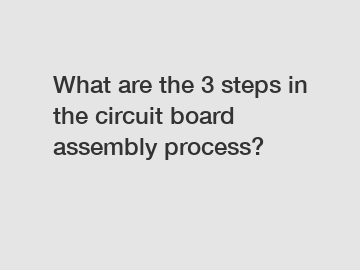What are the 3 steps in the circuit board assembly process?
What are the 3 steps in the circuit board assembly process?
If you have ever wondered about the intricacies of circuit board assembly, you are not alone. These complex boards are the backbone of almost all electronic devices we use in our daily lives. Whether it's your smartphone, computer, or even your car, circuit boards play a vital role in their functionality.
In this article, we will delve into the three key steps involved in the circuit board assembly process, shedding light on the intricate details that go into manufacturing these essential components.

1. Designing the Circuit Board:
The first step in the circuit board assembly process is the design phase. This stage involves creating a blueprint of the circuit board, including the layout of components, connections, and the overall structure. Modern design software allows engineers to design and simulate the circuit board, making it easier to identify potential issues and optimize the design before moving forward.
During the designing process, engineers carefully consider various factors such as component placement, trace routing, and power distribution. They strive to create an efficient and compact design, ensuring that all components are placed in the most optimal positions to enhance functionality and reduce manufacturing costs.
2. Fabricating the Circuit Board:
Once the design is finalized, the fabrication of the circuit board begins. This step involves turning the design blueprint into a physical board. The process typically starts with a flat sheet of non-conductive material, called the substrate or base material.
Using specialized machines, the substrate is coated with a thin layer of conductive material, often copper. This layer acts as a foundation for the circuit's electrical pathways. The excess copper is then removed, leaving behind the desired copper traces and pads based on the initial design.
After the conductive layer is created, the board goes through a series of additional processes, including etching, drilling, and solder mask application. These steps refine the circuit board, ensuring that the traces are well-defined, the holes for component placement are drilled accurately, and a protective solder mask is applied to prevent short circuits and corrosion.
3. Assembling the Components:
The final stage of the circuit board assembly process is the placement and soldering of components onto the fabricated board. This step requires precise alignment and skilled hands to ensure the proper connection between the components and the board.
Surface Mount Technology (SMT) is commonly employed in modern circuit board assembly. SMT components, such as resistors, capacitors, and integrated circuits, come in small, compact packages that can be easily placed on the board using robotic pick-and-place machines.
Once the components are accurately placed, the board moves on to the soldering process. Solder paste, a mixture of small solder particles and flux, is applied to the board using a stencil. The components are then subjected to high temperatures, typically in a reflow oven, which melts the solder and creates permanent electrical connections between the components and the board.
After the soldering process, the circuit board undergoes thorough testing to ensure its functionality. Automated testing equipment checks for defects, shorts, or continuity issues that might impact the performance of the board.
In conclusion, the circuit board assembly process involves three crucial steps: designing the circuit board, fabricating the physical board, and assembling the components. Each step requires meticulous attention to detail and relies on advanced technologies and skilled labor to produce high-quality circuit boards.
Understanding these steps gives us a glimpse into the extraordinary precision and complexity involved in manufacturing the circuit boards that power our modern world. So, the next time you use your favorite electronic device, remember the intricate journey of the circuit board that makes it all possible.
If you are looking for more details, kindly visit pcba for artificial intelligence, medical electronics pcb assembly, security pcb assembly.

Comments
0